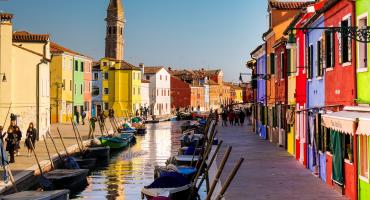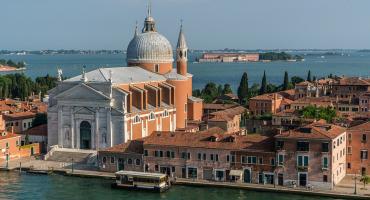For centuries, the 'Spinalonga' has been the holiday resort of the aristocratic families. But, after the first industrialisation, it changed its aspect and became the industrial and manifacturing center of Venice. It is also one of the most populated islands and hotbed of architectural experimentations.
Discover the Giudecca island through the recent city planning, taking a contemporary and unusual look that goes beyond the most famous and usual buildings and landmarks.
The walk will begin from the Western part of the island, Sacca Fisola. It is a working-class area which was built to host the thousands of workmen employed in the area. Afted the Second World War it was a contemporary production workshop.
We will continue our walk to the inner part of the island to observe the great Molino Stucky, the former brewery of Venice, the shipyard and the historical complex Junghans.
We will finish the discovery of the island getting in front of the Casa dei Tre Oci, one of the most interesting symbols of the Venetian neogothic style.
This itinerary has been realised with the intention of going through some of the most important points of the industrial Venice of the XXth Century and discovering a less known part of the city, of its past, its transformation and its present.
The tour wants to recall those places that once were significant production areas and that afterwards became key players of the post-industrial reconversion. In fact, the Giudecca island slowly began a radical change. A significant example is the reconvertion of the industrial structure of the ex-Junghans, which once produced watches and bomb fuses and now it is one of the unconventional theatres of the city.
The walk crosses the whole island and it goes through the places that marked the entire Venetian economy during the XXth Century.

During the XIXth Century, just like other European cities, an adaptation process driven by the new social and industrial measures interested the city of Venice. This kind of change included especially the dismantling of private buildings of their initial functions, such as defense walls or large convents, which best suited themselves to transformation and reconversion.
Venice decided to restore its industrial role thanks to the availability of vast areas of uncultivated land and the possibility of using disabled facilities that were allowed to be converted into factories. The Giudecca island has always been a favorite place for vegetable gardens, gardens and monasteries and it was also the place where the most significant industrial changes took place. Between the XIXth and the XXth Century mills, tanneries, breweries, weaving factories, chemical plants, shipyards, industrial and artistic foundries arose, changing in this way the appeareance of the island. In addition, residential areas were developed both with anonymous construction works and designs thought for the existing architecture.

Despite other cities where the border between modern and contemporary world was clear and obvious, Venice tried to increase moderately the idea of an industrial city trying not to violate its appearance.
This itinerary will reveal a different Venice, which conceals various architectural stratifications and works by esteemed professionals such as Gino Valle, Cino Zucchi, Raphael Moneo, Carlo Aymonino Boris Podrecca, Aldo Rossi and Alvaro Siza who have approached the surrounding urban environment, facing the emergency of the island of a public construction industry addressed to the middle class.
It will be a walk into the secret Giudecca, which will reveal itself in the quiet of the Southern lagoon. We will finally reach the Zitelle, where we can enjoy a breathtaking view of the Zattere and the San Marco basin.
By reservation only
Tel. +39 0415200988
Expected duration: 2 hours and a half



